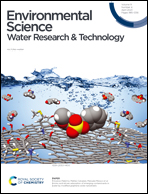Analysis of 13 haloacetamide DBPs in drinking water using a highly sensitive LC-MS/MS method†
Abstract
Human exposure to disinfection by-products (DBPs) primarily occurs through the consumption of drinking water. Haloacetamides (HAcAms) are an emerging class of nitrogenous DBPs with higher levels of cytotoxicity and genotoxicity compared to those of regulated DBPs. Detecting ultra-trace levels of HAcAms in drinking water remains challenging despite the availability of multiple detection methods. This paper reports the first use of ultra-performance liquid chromatography–mass spectrometry/mass spectrometry (UPLC-MS/MS) to quantify 13 HAcAms in drinking water without pretreatment. Results from the analysis of water samples collected from four cities in East China showed total HAcAm concentrations of 0.21–6.12 μg L−1, which were comparable to previously reported data from other countries. Further, 11 out of 13 HAcAms were detected in 60 water samples, with diHAcAms being the predominant subclass. DCAcAm and BCAcAm were the primary HAcAms targeted for detection and two Iodo-HAcAms were detected. The average total HAcAm concentration in water samples disinfected with chloramine was significantly higher than that in water samples disinfected with chlorine. Additionally, the total HAcAm concentrations in water samples from a treatment plant (WTP) using the ozone-biological activated carbon (ozone-BAC) process were lower than those in water samples from WTPs that did not use this treatment process. The results of this study have significant implications for monitoring water quality and protecting human health.



 Please wait while we load your content...
Please wait while we load your content...